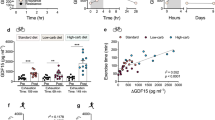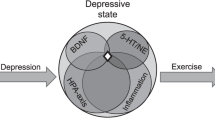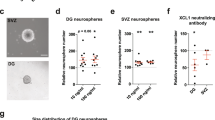Abstract
Exercise has many health benefits, including antidepressant actions in depressed human subjects, but the mechanisms underlying these effects have not been elucidated. We used a custom microarray to identify a previously undescribed profile of exercise-regulated genes in the mouse hippocampus, a brain region implicated in mood and antidepressant response. Pathway analysis of the regulated genes shows that exercise upregulates a neurotrophic factor signaling cascade that has been implicated in the actions of antidepressants. One of the most highly regulated target genes of exercise and of the growth factor pathway is the gene encoding the VGF nerve growth factor, a peptide precursor previously shown to influence synaptic plasticity and metabolism. We show that administration of a synthetic VGF-derived peptide produces a robust antidepressant response in mice and, conversely, that mutation of VGF in mice produces the opposite effects. The results suggest a new role for VGF and identify VGF signaling as a potential therapeutic target for antidepressant drug development.
This is a preview of subscription content, access via your institution
Access options
Subscribe to this journal
Receive 12 print issues and online access
$209.00 per year
only $17.42 per issue
Buy this article
- Purchase on Springer Link
- Instant access to full article PDF
Prices may be subject to local taxes which are calculated during checkout





Similar content being viewed by others
References
Kavanagh, T. Exercise and the heart. Ann. Acad. Med. Singapore 12, 331–337 (1983).
Anderson, B.J. et al. Exercise influences spatial learning in the radial arm maze. Physiol. Behav. 70, 425–429 (2000).
Kramer, A.F. et al. Ageing, fitness and neurocognitive function. Nature 400, 418–419 (1999).
Carro, E., Trejo, J.L., Busiguina, S. & Torres-Aleman, I. Circulating insulin-like growth factor I mediates the protective effects of physical exercise against brain insults of different etiology and anatomy. J. Neurosci. 21, 5678–5684 (2001).
Larson, E.B. et al. Exercise is associated with reduced risk for incident dementia among persons 65 years of age and older. Ann. Intern. Med. 144, 73–81 (2006).
Greenwood, B.N. et al. Freewheel running prevents learned helplessness/behavioral depression: role of dorsal raphe serotonergic neurons. J. Neurosci. 23, 2889–2898 (2003).
Dimeo, F., Bauer, M., Varahram, I., Proest, G. & Halter, U. Benefits from aerobic exercise in patients with major depression: a pilot study. Br. J. Sports Med. 35, 114–117 (2001).
Lai, S.M. et al. Therapeutic exercise and depressive symptoms after stroke. J. Am. Geriatr. Soc. 54, 240–247 (2006).
Kessler, R.C. et al. The epidemiology of major depressive disorder: results from the National Comorbidity Survey Replication (NCS-R). J. Am. Med. Assoc. 289, 3095–3105 (2003).
Greenberg, P.E. et al. The economic burden of depression in the United States: how did it change between 1990 and 2000? J. Clin. Psychiatry 64, 1465–1475 (2003).
Fava, M. & Davidson, K.G. Definition and epidemiology of treatment-resistant depression. Psychiatr. Clin. North Am. 19, 179–200 (1996).
Nibuya, M., Morinobu, S. & Duman, R.S. Regulation of BDNF and trkB mRNA in rat brain by chronic electroconvulsive seizure and antidepressant drug treatments. J. Neurosci. 15, 7539–7547 (1995).
Karssen, A.M. et al. Application of microarray technology in primate behavioral neuroscience research. Methods 38, 227–234 (2006).
Alfonso, J., Frasch, A.C. & Flugge, G. Chronic stress, depression and antidepressants: effects on gene transcription in the hippocampus. Rev. Neurosci. 16, 43–56 (2005).
Duman, R.S. Neurotrophic factors and regulation of mood: role of exercise, diet and metabolism. Neurobiol. Aging 26 (Suppl. 1), 88–93 (2005).
Allen, D.L. et al. Cardiac and skeletal muscle adaptations to voluntary wheel running in the mouse. J. Appl. Physiol. 90, 1900–1908 (2001).
Duman, R.S., Malberg, J. & Thome, J. Neural plasticity to stress and antidepressant treatment. Biol. Psychiatry 46, 1181–1191 (1999).
Russo-Neustadt, A., Beard, R.C. & Cotman, C.W. Exercise, antidepressant medications, and enhanced brain derived neurotrophic factor expression. Neuropsychopharmacology 21, 679–682 (1999).
Neeper, S.A., Gomez-Pinilla, F., Choi, J. & Cotman, C.W. Physical activity increases mRNA for brain-derived neurotrophic factor and nerve growth factor in rat brain. Brain Res. 726, 49–56 (1996).
Salton, S.R. et al. VGF: a novel role for this neuronal and neuroendocrine polypeptide in the regulation of energy balance. Front. Neuroendocrinol. 21, 199–219 (2000).
Nedivi, E., Wu, G.Y. & Cline, H.T. Promotion of dendritic growth by CPG15, an activity-induced signaling molecule. Science 281, 1863–1866 (1998).
Naeve, G.S. et al. Neuritin: a gene induced by neural activity and neurotrophins that promotes neuritogenesis. Proc. Natl. Acad. Sci. USA 94, 2648–2653 (1997).
Tong, L., Shen, H., Perreau, V.M., Balazs, R. & Cotman, C.W. Effects of exercise on gene-expression profile in the rat hippocampus. Neurobiol. Dis. 8, 1046–1056 (2001).
Eagleson, K.L., Fairfull, L.D., Salton, S.R. & Levitt, P. Regional differences in neurotrophin availability regulate selective expression of VGF in the developing limbic cortex. J. Neurosci. 21, 9315–9324 (2001).
Levi, A., Eldridge, J.D. & Paterson, B.M. Molecular cloning of a gene sequence regulated by nerve growth factor. Science 229, 393–395 (1985).
Newton, S.S. et al. Gene profile of electroconvulsive seizures: induction of neurotrophic and angiogenic factors. J. Neurosci. 23, 10841–10851 (2003).
Hahm, S. et al. Targeted deletion of the Vgf gene indicates that the encoded secretory peptide precursor plays a novel role in the regulation of energy balance. Neuron 23, 537–548 (1999).
Alder, J. et al. Brain-derived neurotrophic factor–induced gene expression reveals novel actions of VGF in hippocampal synaptic plasticity. J. Neurosci. 23, 10800–10808 (2003).
Cryan, J.F., Markou, A. & Lucki, I. Assessing antidepressant activity in rodents: recent developments and future needs. Trends Pharmacol. Sci. 23, 238–245 (2002).
Dulawa, S.C. & Hen, R. Recent advances in animal models of chronic antidepressant effects: the novelty-induced hypophagia test. Neurosci. Biobehav. Rev. 29, 771–783 (2005).
Salton, S.R. Neurotrophins, growth-factor–regulated genes and the control of energy balance. Mt. Sinai J. Med. 70, 93–100 (2003).
Vaynman, S., Ying, Z. & Gomez-Pinilla, F. Hippocampal BDNF mediates the efficacy of exercise on synaptic plasticity and cognition. Eur. J. Neurosci. 20, 2580–2590 (2004).
Ying, Z., Roy, R.R., Edgerton, V.R. & Gomez-Pinilla, F. Exercise restores levels of neurotrophins and synaptic plasticity following spinal cord injury. Exp. Neurol. 193, 411–419 (2005).
McEwen, B.S. & Chattarji, S. Molecular mechanisms of neuroplasticity and pharmacological implications: the example of tianeptine. Eur. Neuropsychopharmacol. 14 (Suppl. 5), S497–S502 (2004).
Lu, B., Greengard, P. & Poo, M.M. Exogenous synapsin I promotes functional maturation of developing neuromuscular synapses. Neuron 8, 521–529 (1992).
Cui, X.S. & Kim, N.H. Polyamines inhibit apoptosis in porcine parthenotes developing in vitro. Mol. Reprod. Dev. 70, 471–477 (2005).
Newton, S.S., Collier, E.F., Bennett, A.H., Russell, D.S. & Duman, R.S. Regulation of growth factor receptor bound 2 by electroconvulsive seizure. Brain Res. Mol. Brain Res. 129, 185–188 (2004).
Kishi, T. & Elmquist, J.K. Body weight is regulated by the brain: A link between feeding and emotion. Mol. Psychiatry 10, 132–146 (2005).
Vaynman, S.S., Ying, Z., Yin, D. & Gomez-Pinilla, F. Exercise differentially regulates synaptic proteins associated to the function of BDNF. Brain Res. 1070, 124–130 (2006).
Duman, R.S. & Monteggia, L.M. A neurotrophic model for stress-related mood disorders. Biol. Psychiatry 59, 1116–1127 (2006).
Newton, S.S., Dow, A., Terwilliger, R. & Duman, R. A simplified method for combined immunohistochemistry and in situ hybridization in fresh-frozen, cryocut mouse brain sections. Brain Res. Brain Res. Protoc. 9, 214–219 (2002).
Koo, J.W. et al. The postnatal environment can counteract prenatal effects on cognitive ability, cell proliferation, and synaptic protein expression. FASEB J. 17, 1556–1558 (2003).
Acknowledgements
We would like to thank S. Salton (Mount Sinai School of Medicine) for providing us with male C57BL/6J mice; J.W. Koo for his assistance with the restraint studies; J.W. Koo and J. Quinn for their assistance with the statistical analysis; and K. Patterson and C. Montgomery for assistance in breeding and genotyping VGF-mutant mice. We would like to acknowledge the support of the National Research Service Award fellowship, US National Institute of Mental Health grants MH25642 and MH45481, US NIH grants DK57702 and NS45305, the US National Alliance for Research on Schizophrenia and Depression grants DK-071308 andU24 NS05186, and the Connecticut Mental Health Center.
Author information
Authors and Affiliations
Contributions
J.G.H. assisted with all aspects of the research, including optimization of the microarray and data analysis, conducted all other molecular and behavioral experiments, and prepared the original draft of manuscript. S.S.N. was responsible for the development, optimization and experimental use of custom array. A.H.B. assisted in the optimization, use and analysis of microarrays. C.H.D. assisted in development of the running procedure and behavioral analysis. D.S.R. assisted in analysis of the microarray data, PC12 culture work and discussion of results. S.R.S. assisted in conceptual aspects of the studies, the development of VGF-mutant mice and interpretation of the data. R.S.D. was involved in the development of the overall study design, data analysis, interpretation of results and the preparation of manuscript and figures. All authors discussed results and contributed intellectually to the manuscript.
Corresponding author
Supplementary information
Supplementary Text and Figures
Supplementary Tables 1–6, Supplementary Figs. 1 and 2, Supplementary References and Supplementary Methods (PDF 763 kb)
Rights and permissions
About this article
Cite this article
Hunsberger, J., Newton, S., Bennett, A. et al. Antidepressant actions of the exercise-regulated gene VGF. Nat Med 13, 1476–1482 (2007). https://doi.org/10.1038/nm1669
Received:
Accepted:
Published:
Issue Date:
DOI: https://doi.org/10.1038/nm1669
This article is cited by
-
The mechanisms, regulations, and functions of histone lysine crotonylation
Cell Death Discovery (2024)
-
An increase in VGF expression through a rapid, transcription-independent, autofeedback mechanism improves cognitive function
Translational Psychiatry (2021)
-
VGF-derived peptide TLQP-21 modulates microglial function through C3aR1 signaling pathways and reduces neuropathology in 5xFAD mice
Molecular Neurodegeneration (2020)
-
Neural maturation enhanced by exercise-induced extracellular derivatives
Scientific Reports (2020)
-
Human VGF-Derived Antidepressant Neuropeptide TLQP62 Promotes SH-SY5Y Neurite Outgrowth
Journal of Molecular Neuroscience (2020)



